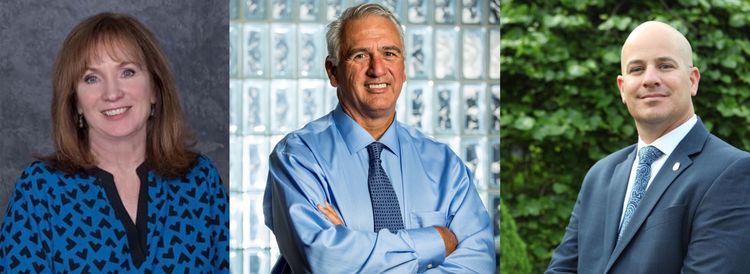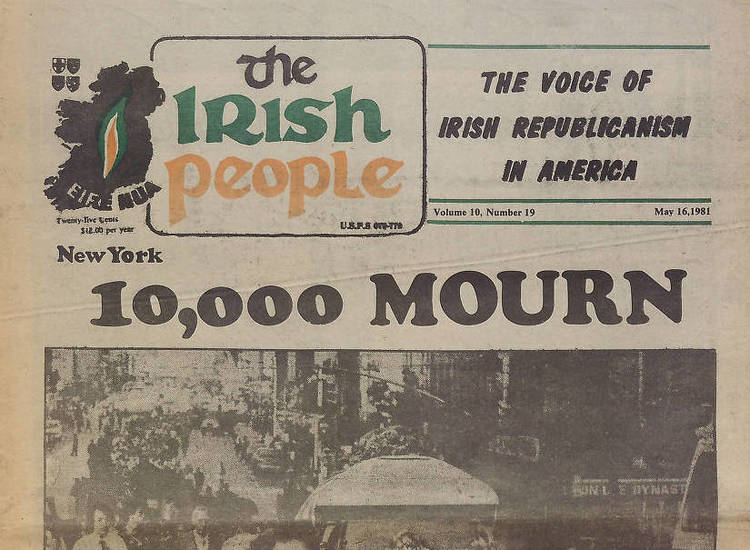[caption id="attachment_70200" align="aligncenter" width="600" caption="Kevin Roche pictured with a model of a New York University dormitory building at the headquarters of Kevin Roche John Dinkeloo and Associates LLC in Hamden, Conn. PHOTO BY PETER MCDERMOTT"]
Kevin Roche is not resting on his laurels.
That much was evident at a panel discussion on his work in January at the Museum of the City of New York. The institution at 103rd Street and 5th Avenue was at the time exhibiting “Kevin Roche: Architecture as Environment,” which originated at Yale and will likely be seen in the city of his birth, Dublin.
One of the panelists on that evening, Eeva-Liisa Pelkonen, has said that Roche is the first of his profession “to see architecture and nature as one." Audience members might have expected, then, that the County Cork-raised architect would sit back while she and the two other experts discussed his 65-year career, which has seen him win every important award, including the Pritzker Prize, architecture’s equivalent of the Nobel.
Instead, it became “The Kevin Roche Show.” The centerpiece was a slideshow presentation in which he gave an overview of the major architectural styles since antiquity and explained some of the decisions he and his colleagues made when building structures such as the Museum of Jewish Heritage in Lower Manhattan, the headquarters of the Santander Central Hispano in Madrid and the head office for Bouygues SA Holding company in the center of Paris.
Although, he was focused mainly on current and recent projects, he displayed powers of instant recall when asked about details of buildings he’d worked on decades ago. And he did all of this in his soft-spoken way.
“Ego is dangerous in architecture,” he told the attendance of about 150. “It’s not the point of what we’re doing.
“We’re trying to create civilization,” he said. “We’re trying to help create community.”
Patriotic father
Roche, who will turn 90 in early summer, has simple explanations for his success. “I sort of lucked into everything. I just had a certain amount of drive,” he said in an interview at his office in Hamden, Conn. “I was here without family, without money, without a name. You’re in the situation where you’ve got to perform.”
He was born on June 22, 1922, just days before the outbreak of the Irish Civil War, a conflict that landed his father behind bars for a second time. Éamon de Róiste, as he was known during his revolutionary career, had already done a spell in prison during the 1919-21 War of Independence. On Jan. 7, 1922, he was one of the 57 Dáil members who voted against ratification of the Anglo-Irish Treaty that had been signed by Michael Collins and Arthur Griffith in London. The most famous oppositional voice was that of de Róiste’s lifelong friend, and future taoiseach and president, Éamon de Valera, who also grew up Bruree, Co. Limerick.
The architect’s mother, the former Alice Harding, was raised on a tiny farm outside Tipperary Town. “There were about 10 daughters and two sons. They grew up in a two-room cottage,” he said, “and they became teachers all over the world, in England, Scotland, America and Australia.” Some in the next generation became very successful in business, he added.
After the end of the Civil War, Éamon and Alice Roche left politics behind and settled down with their young children in Mitchelstown, Co. Cork, where he’d been appointed manager of a small creamery. It grew into Ireland’s biggest and most famous cooperative.
“He was very smart and had a great imagination,” he said of his father who left school at 12.
Roche pioneered the bulk manufacturing of cheese. He also transformed dairy farming in the region with the introduction of artificial insemination.
By the early 1930s, the Mitchelstown network of creameries had a daily milk intake of 29,000 gallons.
Some years later, Kevin Roche’s father allowed him to oversee the construction of cheese warehouses and when he was a first-year college student, he gave him his first opportunity to design a building: a piggery that accommodated 1,000 pigs.
“They were very satisfied customers,” he said, with a laugh, “probably the most satisfied I ever had.”
Kevin, the youngest of the Roches’ four children (their eldest, and only daughter, died at age 12) was a “terrible student” at the Christian Brothers school in Mitchelstown and his report cards confirmed it. “I didn’t even qualify to fail,” he said.
But at Rockwell College, the boarding school run by the Holy Ghost Fathers in Cashel, Co. Tipperary, he found his calling when he read some books on the subject in the school library. When he graduated from Rockwell, he enrolled in a class of 10 architectural students at the Earlsfort Terrace campus of University College Dublin. The course, he said, remembering a city cut off from Europe by war, was dominated by Greek revivalism.
New horizons
After graduation, Roche worked with Dublin’s (Michael Scott, “he was quite a character”) and London’s (Matthew Fry) best-known architects, but he was anxious to broaden his horizons. He applied to and was accepted by both Harvard and Yale in 1948; instead he took up the offer to go to study at the Illinois Institute of Technology under Edwin Ludwig Mies van der Rohl. Mies had left Europe at age 50 because the Nazis declared his architecture “not German.”
Ultimately, Roche found the approach at IIT too rigid. “It was like a religion. There were mortal sins and venial sins,” he recalled. “It made nice architecture for the moment, but it didn’t embrace the whole problem of why we were there, [and] what we were doing.”
He left after a year because he wanted to work on the United Nations building in New York. When that job was finished, he lived a precarious jobless existence for a few months. One UN contact, however, got him an interview in 1950 with Eero Saarinen, a Michigan resident who had been emerging as one of the nation’s top architects. Like Roche, he was foreign-born. He’d arrived in America at age 13 with his father, the prominent architect Eliel Saarinen.
“Eero was wonderful because he had the Finnish humanist approach to things,” Roche remembered. “He was very, very interested in trying to make something that was meaningful.”
Four years on, in 1954, Roche was appointed Saarinen’s chief design associate and worked on all of his projects with him.
The Irishman said his mentor worked constantly because he enjoyed it. He recalled that on one occasion he was so engrossed in projects he was surprised when someone told him it was New Year’s Day.
When news came through in 1961 that Saarinen had died at age 51, Roche was in a meeting. He made the sad announcement and then went on with the meeting because that’s what the boss would have done.
Roche and his fiancée Jane, who is from Toledo, Ohio, were due to marry the following week, but postponed the wedding until the company’s move from Bloomfield Hills, Mich., to Hamden could be completed. A half century on, the couple, who are the parents of five children and grandparents to 12, live just a short drive from the Hamden offices.
Non-stop work
Saarinen’s main protégés Roche and John Dinkeloo, who specialized in the construction side of the operation, made their reputations initially by completing the 10 projects that he’d left unfinished at the time of his death. They included Dulles International Airport, CBS Headquarters and the TWA terminal at JFK.
“We worked every day,” Roche recalled. “We worked 10 hours a day, for years and years.”
Dinkeloo, who Roche once described as having a “forceful personality,” insisted that the partners also enter competitions. The first important one was for the Oakland Museum of California. Shortly after that, they were working on the Knights of Columbus building in nearby New Haven, and the Ford Foundation headquarters in Manhattan.
Their success was made possible by the path that Saarinen had forged: his reputation, his goodwill and his press contacts (he’d wanted to move to Connecticut because he second wife was a New York-based journalist).
“You couldn’t start from scratch yourself,” Roche said.
The founder’s will stipulated that his practice would retain his name for five years after his death. In 1966, the company became Kevin Roche John Dinkeloo and Associates or simply Roche-Dinkeloo, or KRJDA.
Dinkeloo died in 1981. The following year, the prominent critic and scholar Paul Goldberger reported in the New York Times: “Kevin Roche, the architect known for such crisp and inventive abstractions in glass and masonry as the Ford Foundation building and the United Nations Plaza Hotel, was named the winner of the $100,000 Pritzker Prize in architecture yesterday. At the presentation ceremonies, in the Whitney Museum, Mr. Roche announced his intention of using the prize money to begin an endowment fund for a chair of architecture at Yale University in honor of Eero Saarinen, the architect with whom Mr. Roche worked closely until Saarinen's death in 1961.”
Early on, Roche developed a reputation as an innovator and as a communicator. He once saw reflective sunglasses on the cover of Life magazine and it occurred to him that the same principles could be used in buildings. He understood, too, that while members of his profession were obsessively attached to architectural drawings, clients didn’t understand them. So he pioneered slideshows and other presentations that conveyed ideas more easily to lay people.
Fiction and non-fiction
In doing headquarters for corporations, and it has done many, Roche-Dinkeloo has tried to avoid a common pitfall. “You’re designing things for people, but you never think about the people,” Roche said. “You just assume you know it all; that’s the worst possible thing, because you don’t.”
That sort of blindness has led to some ill-conceived planning, such as putting economically disadvantaged people in high-rises. “Then we walk away,” Roche said.
The ideal model for human living might be the 18 and 19th English village, though he wouldn’t like to live in such a situation himself, no more than he could live on a high floor.
He and his wife spend weekends during certain times of the year at their apartment at Lexington Avenue and 64th Street in Manhattan. It’s on the 2nd floor.
Much as he enjoys weekends off, Roche couldn’t imagine not working. “I don’t go on vacation,” he said. “I don’t have any interests.”
However, he does read. Jane Austen is a favorite, and while he admires his fellow Michelstown native William Trevor and liked some of the earlier books of Roddy Doyle and Martin Amis, he feels that fiction has lost its way somewhat.
One non-fiction book he read recently described the impact that the Welsh, the Scots, the Irish and others have had on the English language. He could see the parallels with architecture.
“It’s absolutely fascinating when you walk down the street in New York and you ask ‘how did this happen?’ and ‘how did that happen?’”
When he sees a building, he’s wonders, too, about the “energy, commitment, hope, expectation and human spirit” that went into it and, if it’s a home, he’s curious about the family story.
In a Manhattan street, one can see, the world-renowned architect Roche said, “100 years of expectations.”









